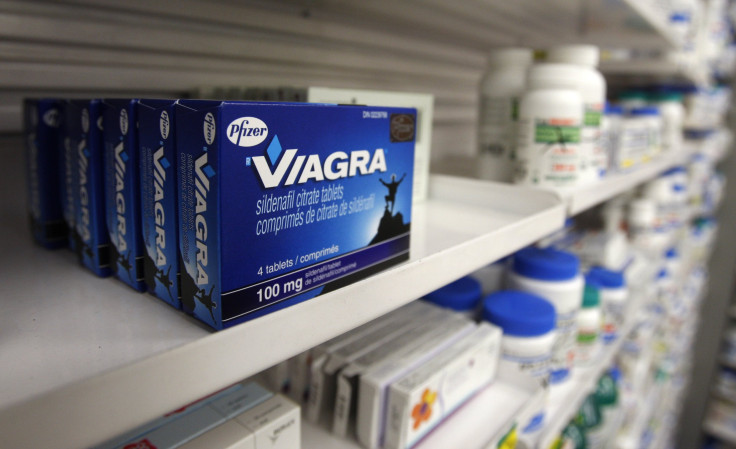Viagra’s New Ad Campaign Targets Women

Viagra is for men, but a new ad campaign uses women to market the now-famous little blue pill. Pfizer will begin airing the campaign's first TV commercial for the erectile dysfunction drug on Tuesday. The 60-second ad has a blonde, blue-eyed woman reclining on a bed in a tropical setting.
"So guys, it's just you and your honey," she says. "The setting is perfect. But then erectile dysfunction happens again. Plenty of guys have this issue -- not just getting an erection, but keeping it."
Instead of using the industry euphemism “ED,” the actress uses the word “erection” instead. In the past, ad campaigns typically featured middle-aged men doing construction work or fishing. They were "built around very subtle innuendo,” Pfizer's marketing chief, Vic Clavelli, told the Associated Press. Besides the television spot, print ads will run in Esquire and Time magazine, encouraging women to speak with their partners about the problem.
BBDO New York, the creative agency behind the current campaign, says they went with a more direct approach.
"This is an example of a very simple, straightforward story well told via an execution that I would say uses a direct, honest, compassionate approach to simply let men with ED know they are not alone," John Osborn, president of BBDO New York, told Ad Age. "It was our belief that this approach would put men at ease."
“This is a fumble,” Katie Rogin, managing director of strategic planning of Havas Worldwide Tonic, told International Business Times about the new Viagra ads. She says the three major erectile dysfunction drugs have carved out three distinctive territories in the marketplace. “Levitra was about performance. Cialis was about a man’s relationship with his partner. Viagra was about function,” Rogin said. Viagra ads showed men doing manly things. “[The new ad] seems to violate that positioning.”
Not only does the new ad campaign take place outside a construction site, sailboat or ranch, but a man is never shown on screen. “It’s rare to see pharmaceutical spot that doesn’t show the target,” Rogin said. Strictly speaking, the ads might be considered misleading -- which could be a violation of the US. Food and Drug Administration’s policies on prescription drug advertising.
The female-oriented advertising strategy is a first for Pfizer -- the world’s second biggest drug maker -- and comes after a new wave of cheaper generic versions of Viagra have entered the market since the company's patent expired 15 months ago. Sales dropped 8 percent last year to $1.9 billion. A YCharts report predicts that all branded erectile dysfunction drug sales will fall at a compounded annual rate of 4.5 percent from 2013 to 2019. The new ad campaign may be trying to reach a broader audience before generic brands are offered in three years time.
Viagra costs about $35 a pill, the Associated Press reports. Medicare and many insurance plans do not cover erectile dysfunction drugs. If they do, insurers typically pay for four pills a month. But other options such as pumps, injections and surgical implants are covered, the New York Times reports.
Generic versions of Viagra are available in Europe. They are expected to hit U.S. markets in three years.
Introduced in 1998, Viagra was the first erectile dysfunction drug in the U.S. Cialis and Levitra followed in 2003. Since then, the little blue pills have been endorsed by former presidential nominee Bob Dole, actor Michael Douglas and have been a storyline on HBO’s “Sex and the City.”
Drug patents generally last for 20 years. After they expire, cheaper versions of the drug enter the market to compete with -- and sometimes crush -- brand-name competition.
Erectile dysfunction is big business. Last year, Viagra, Cialis and Levitra made more than $2.5 billion, NPR reports. According to a study conducted by Johns Hopkins Bloomberg School of Public Health, about 18 million men in the U.S. have ED.
Erectile dysfunction "happens to all men," Dr. Jacob Rajfer, a urologist at UCLA Medical School told NPR. “Men in their forties have a 40 percent chance of having this problem," Rajfer said. "For every decade after 40, there's a 10 percent increase."
Viagra’s new commercial will appear during the shows "CSI," ''Blue Bloods" and "48 Hours" – hit primetime shows with older adult audiences. "No one has taken directly the perspective of a partner and used that as a way to motivate men," Clavelli told Ad Age about the new Viagra ad. "We think we're doing that here."
© Copyright IBTimes 2024. All rights reserved.






















